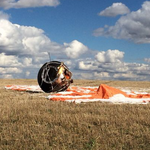Space

2014RC is a 60 foot (or about 20 meter) wide asteroid detected at the last possible minute. This small asteroid will not hit Earth. What about the ones like it that eventually will? I ask that question because it is a certainty the last time Earth was hit by an asteroid of this size wasn't the last time forever. If it was going to hit there are three things we could do about it.
Some facts about 2014RC
Based on our detecting it at the last minute, odds are it is made of a very dark material. Likely mostly stony with a small amount of carbon. At 20 meters…

2014RC is a 60 meter wide asteroid detected at the last possible minute. This small asteroid will not hit Earth. What about the ones like it that eventually will? I ask that question because it is a certainty the last time Earth was hit by an asteroid of this size wasn't the last time forever. If it was going to hit there are three things we could do about it.
Some facts about 2014RC
Based on our detecting it at the last minute, odds are it is made of a very dark material. Likely mostly stony with a small amount of carbon. At 60 meters wide and a density…
By Tanya Hill, University of Melbourne
Have you ever considered our cosmic address? It’s a fun device I’ve often used to help students get a grasp on our place in the universe.
For example, I work at the Melbourne Planetarium, 2 Booker St, Spotswood, Victoria, Australia, Earth, Solar System, Orion Arm, Milky Way Galaxy, Local Group, Virgo Cluster, Local Supercluster, the Universe.
Well, today, as a result of a paper published in Nature, there is now an improved descriptor to add that address - the Laniakea Supercluster. The name Laniakea means immense heaven in Hawaiian.
A slice of the…

You have a new galactic address; astronomers have determined that our own Milky Way galaxy is part of a newly identified enormous supercluster of galaxies - dubbed "Laniakea," which means "immense heaven" in Hawaiian.
This discovery broadens the boundaries of our galactic neighborhood and establishes previously unrecognized linkages among various galaxy clusters in the local Universe. How big are are talking? The Milky Way galaxy alone has 100 billion stars. We think. And then there are 1012 galaxies. So your address is now a lot bigger. Instead of being Earth, Sol, Orion arm, Milky Way…

The Foton-M4 descent capsule with famed reptilian cosmonauts, known affectionately as the "sex geckos" (owing to the carnal nature of their space voyage), and also with drosophila fruit flies, seeds of plants, has landed in the Orenburg Region, an official in the press service of Russia's Federal Space Agency (Roscosmos) told ITAR-TASS on Monday.
The touchdown of the Foton spacecraft took place at 09:18 UTC, Roscosmos announced around half an hour after the fact. After landing, the recovery team started rushing to the vehicle. Once reaching the landing site, a field lab was established to…

Observations made by the Kepler spacecraft have shown that Kepler-413b is a very wobbling exoplanet. The planet's orbit is unusual in that it is tilted 2.5 degrees with respect to the plane of the binary star's orbit.
Over an 11-year period, the planet's orbit too would appear to wobble as it circles around the star pair. That kind of behaviour of transiting circumbinary planets (planet that orbits two stars) or CBP was first predicted in 1994 by Jean Schneider. He detailed his predictions in "On the occultations of a binary star by a circum-orbiting dark companion". Kepler-413b is…
Many of us care deeply about the possibility of tigers, lemurs and such like becoming extinct in the wild. I'd like to suggest that we care as much about the possibility of microbes on Mars and elsewhere in our solar system becoming extinct through human activities.
So what's so special about microbes on Mars? Well first, the uniqueness. Tigers are closely related to cats. They are wonderful and remarkable creatures - and would be a tremendous shame to lose them - but basically it's the familiar tabby in another guise.
For microbes on Mars though - the most interesting possibility is that…
Many people care deeply about the possibility of tigers, lemurs and such like becoming extinct in the wild. I'd like to suggest we care as much about the possibility of microbes on Mars and elsewhere in our solar system becoming extinct through human activities.
So what's so special about microbes on Mars? Well first, the uniqueness. Tigers are closely related to cats. They are wonderful and remarkable creatures - and would be a tremendous shame to lose them - but basically it's the familiar tabby in another guise.
For microbes on Mars though - the most interesting possibility is that…
Many people care deeply about the possibility of tigers, lemurs and such like becoming extinct in the wild. I'd like to suggest we care as much about the possibility of microbes on Mars becoming extinct. And more so.So what's so special about microbes on Mars? Well first, the uniqueness. Tigers are closely related to cats. They are wonderful and remarkable creatures - and would be a tremendous shame to lose them - but basically it's the familiar tabby in another guise.
For microbes on Mars though - the most interesting possibility is that they may be unrelated to any living…

Astrophysicists have detected the formation of radioactive cobalt during a supernova explosion, lending credence to a corresponding theory of supernova explosions.
The article's main author, Yevgeny Churazov (Space Research Institute of the Russian Academy of Sciences), and co-authors, including Sergei Sazonov of the Space Research Institute and MIPT, reported the results of their analysis of data collected with the INTEGRAL gamma-ray orbital telescope, which they used to detect the radioactive isotope cobalt-56(56Co).
Isotope 56Co has a half-life of just 77 days, and does not…